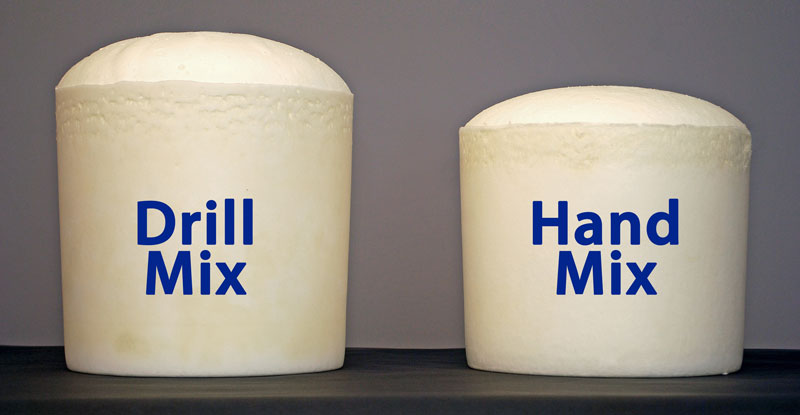Q: What types of foam does Smooth-On offer?
Smooth-On offers a variety of foam materials including our Foam-iT!® series rigid polyurethane foams, FlexFoam-iT!® series flexible polyurethane foams, and Soma Foama® series platinum-based silicone foams.
Q: What does the number associated with each foam represent?
Each Smooth-On foam has a number associated with it that represents the free-rise density or cubic foot "yield-per-pound" of the foam. Larger numbered foams have a higher density, whereas lower numbered foams have higher expansion rates.
For example, if you poured Foam-iT! 5 liquid into a cube measuring one cubic foot and the foam expanded to 12"x12"x12", it would weigh 5 lbs. If you pour Foam-iT! 10 liquid into the same cube, it would fill the same space and again expand to 12"x12"x12" (1 cubic foot). However, the Foam-iT! 10 cube would weigh 10 lbs. due to a higher density.
Q: What makes Foam-iT! and FlexFoam-iT! foams different from other foams?
The raw materials used to make them. Smooth-On never uses "off spec" or "waste stream" polyols that are often used to formulate foams for making products like furniture, shoes and other commodities. Smooth-On also uses filtered water in the production of its foams. As a result, Smooth-On foams have higher physical and performance properties than waste stream foams. With several densities to choose from, Smooth-On foams are premium formulations that are consistent from batch to batch ensuring the user a more predictable outcome every time.
Q: Are Foam-iT! and FlexFoam-iT! "water-blown" foams or "solvent-blown" foams?
Foam-iT! and FlexFoam-iT! castable foams are water-blown polyurethane foams that expand and cure quickly to solid, strong, lightweight foams. These types of foams are also known as "cold foam" because they do not require baking in an oven to cure. They are designed to be processed and cure at room temperature (73°F / 23°C).
Q: Are Foam-iT! rigid foams "closed cell" or "open cell"?
Foam-iT! rigid foams are closed cell. Closed cell foams provide a better surface finish, especially when backpressure is applied during casting. Closed cell foams also provide better water resistance. Flex Foam-iT! flexible foams are "hybrid" foams, they combine characteristics of both closed-cell and open-cell foams with a mixture of closed and open cells within the matrix. Even though Flex Foam-iT! foams have some open cells, they do not fully absorb water when cured.
Q: How flexible are FlexFoam-iT! foams?
All of the FlexFoam-iT! foams are flexible, but some are more pliable than others. FlexFoam-iT! III, V, VI, VIII and X are very pliable or supersoft foams. On the other hand, FlexFoam-iT! IV, 17 and 25, although still bendable, exhibit a more tight foam cell structure and are less "squishy" compared to the supersoft foam versions.
Q: I am looking for "iso foam"; is this something that Smooth-On makes?
Yes, Smooth-On's Foam-iT! and FlexFoam-iT! series are both iso foam formulations, making them very high quality while being easy to use. These foams are also commonly referred to as "AB foams" in reference to their two-component (Part A & Part B) nature.
Q: Does it matter whether I mix Foam-iT! or FlexFoam-iT! liquid castable foams by hand or drill mix?
Drill mixing (using a drill with mechanical mixer attachment, such as a "turbine" mixer) will introduce more air into the system, causing the foam to expand more. Below is an image showing the difference between drill mixing and hand mixing.

Q: How do I paint fully cured Foam-iT! rigid foam and FlexFoam-iT! flexible foam?
To Paint Foam-iT! Rigid Foam: You can prime and paint the cured surface of rigid foams in the same way that you would cured resin. First prime the casting using 1-2 coats of a high quality auto body primer followed by acrylic enamel paints.
To Paint FlexFoam-iT! Flexible Foam: If you attempt to paint a flexible foam with a standard latex or acrylic paint, the painted surface could crack when the flexible foam part is flexed. You need a paint that will bend and flex with the flexible foam.
Your best option: Maker Pro Paints™ are industrial-grade, professional paints developed for rigorous themed environment applications at amusement parks, zoos, aquariums, etc., where outdoor durability is critical. When mixed with the FLEX Additive, Maker Pro Paints™ will become more elastic and bond to flexible or semi-rigid substrates, including fabrics, semi-rigid urethane resins, flexible urethane foams, urethane rubbers, and latex rubbers.
Other options: UreCoat™ is easily colored with SO-Strong™, UVO™ or Ignite™ colorants to create a permanent paint for coating cured Smooth-On urethane rubbers or flexible foams. In addition, some customers have used our Brush-On 40 urethane rubber thinned with a small amount of mineral spirits as a paint. It is easily color pigmented with SO-Strong color tints. You can also paint the cured surface of flexible foam with fabric paint or flexible acrylic enamel paints. You must make sure the paint adheres to the foam and is flexible after it dries.
Q: Is there a way to improve surface finish when casting Foam-iT! rigid foam and FlexFoam-iT! flexible foam?
You can obtain a better surface finish when casting foam by utilizing back pressure. Read our guide on improving the surface finish of foam.
![[Return to Homepage]](/assets/imgs/RAMlogo.png)
